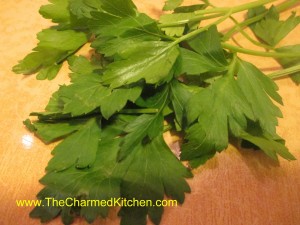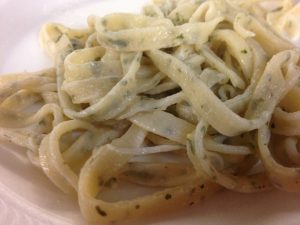Why I Love Parsley
Parsley is one of those herbs everyone seems comfortable using- and with good reason. The clean, green flavor goes well with so many foods. Even people who rarely cook with herbs, seem OK using parsley. Because it is used so commonly, I think it often gets overlooked. Parsley is loaded with Vitamin C and chlorophyll for starters. It is also easy to grow.
While thought of as more of a garnish by some, the flavor can often brighten up a dish. Parsley goes well with meats, veggies, pasta, rice and more. I sometimes use it as a base for pesto. It is also essential to add when making soup stocks.
Since the leaves are so tender- you don’t need to cook it to use it. In fact, you should be careful not to overcook it in dishes. Adding chopped parsley right at the end of cooking, most times, is best. It will add a fresh flavor and a burst of green color to your food.
There are three main types of parsley- the flat leaved or Italian parsley. This is the best one for cooking. It has so much flavor. There is also the curly leaved type. This one is cute and often best suited for garnish. Tasty, but not nearly as much flavor as its flat leafed cousin. The third type is root parsley. This one produces a pretty big tap root that is great for using in soup stocks. The plants are dug up and roots are used fresh- or frozen for later use.
Here are some recipes featuring parsley.
Parsley Pasta- Linguine
1 c. flour
2 T. chopped fresh parsley
1 egg
1 T. oil, (optional)
2-4 T. water, if needed
Combine the ingredients in a food processor, then let the dough rest before rolling. Once you are ready to roll out your pasta, the shape is up to you. You can hand roll the pasta, and cut into noodles. I use a pasta maker to roll the dough, and then a cutting attachment for linguine. Fresh pasta cooks fast. Cook in boiling water 1-2 minutes. Drain and toss with butter, oil, or your favorite sauce.
Zucchini Soup with Herbs
2 medium onions, chopped
2 T. oil or butter
2 qts. chicken or vegetable stock
6 cups cubed zucchini
¼ c. raw brown or white rice
2 T. flour
1T. oil
½ c. fresh chopped parsley
2 T. fresh basil, chopped
1 t. oregano
½ t. thyme
salt and pepper to taste
Sauté onion in 2 T. oil or butter until slightly browned. Add stock, zucchini, and rice. Simmer until rice is cooked, about 40 minutes for brown, or 15 – 20 minutes for white rice. In small bowl combine flour with remaining oil and blend until smooth. Add a little hot soup and whisk until smooth. Pour flour mixture into the soup then add herbs and other seasonings. Simmer for 3 – 4 minutes and serve. Serves 6 – 8.
Parsley Potatoes
2 lbs. potatoes, I prefer Yukon Gold or red-skinned
2-3 c. chicken or vegetable stock
4 T. butter or oil
½ c. fresh chopped parsley, or a bit more to taste
Salt and pepper to taste
Prep potatoes: Peel potatoes, if desired. Large potatoes can be cut into quarters, medium potatoes in half. Small potatoes can be left whole. You want them in chunks about 2 inches in size. Place potatoes in a pot with the stock. Over medium heat, bring to a simmer. Cook, uncovered, until the potatoes are tender and most of the liquid is cooked off. Reduce heat so they don’t scorch. Add butter, parsley and seasonings and cook over low heat until the butter has melted. Adjust seasonings and serve. Serves 6.
Grow Your Own
Lets look at growing parsley for a minute. Parsley likes a sunny location, but will tolerate some shade and does very well in pots and hanging baskets. Its fern- like leaves can be planted among flowers and look quite nice.
Parsley is a biennial. That means it produces only leaves the first year. The second year it makes flowers and seeds, then dies. For my part of the world that means I get a harvest of parsley leaves all summer long. Right up until frost I am harvesting. When Spring arrives it sprouts early, with beautiful leaves. Soon after it will produce flowers and seeds. Since I know the plant is going to die anyway I harvest all the leaves that second year – as soon as they start emerging – and freeze and dehydrate them for later use. This gives me a great harvest early in the year.
General Use
Parsley holds most of its flavor when dried and freezes great, too. In milder climates, parsley may defy the odds and produce for a third year, before making seeds.
Don’t discard those stems, either. While the leaves and small stems are chopped up for fresh eating, the stems can be used to flavor stocks. I often freeze them- then add to the pot when making a stock. Too tough for eating, they are still full of flavor and are getting strained out anyway.
The tradition of using a sprig of parsley to garnish a plate was not just to decorate the plate. It was placed there to be nibbled as a way to freshen your breath after dinner.
So don’t dismiss parsley as just a garnish. It really is a great, simple and clean tasting herb that can brighten up most any dish it is added to.






